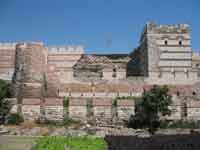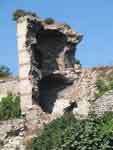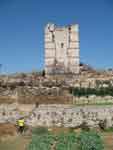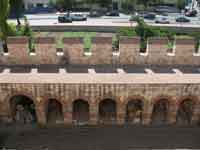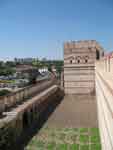.

Map showing Constantinople and its walls
The Walls of Constantinople surrounded the Roman and Byzantine city of Constantinople (today Istanbul in Turkey).
The original walls of the city were built in the 8th century BC when Byzantium was founded by Greek colonists from Megara. At the time the city covered an acropolis and little more. The colony was relatively unimportant by the Roman period, but Septimius Severus built a new set of walls during his reign, bringing more land into the city. When Constantine moved the capital of the empire to Byzantium, which he renamed Constantinople, he greatly expanded the walls of the city, incorporating even more territory.
The final set of walls were built during Theodosius II, stretching almost seven kilometres from the Golden Horn to the Sea of Marmara. Although named after Theodosius they were actually constructed under the direction of Anthemius, prefect of the Eastern Empire, beginning in 413. They were built in response to the threat from the Huns, on higher ground than the old Severan Wall. In 439 the first sea walls were built. In 447 the walls were damaged by an earthquake, and were quickly rebuilt in time to stop Attila's army.

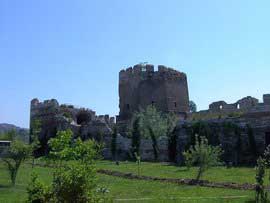
Sections of the Theodosian walls of Constantinople as they appear today in suburban Istanbul
 |
||
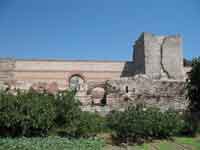 |
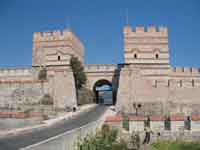 |
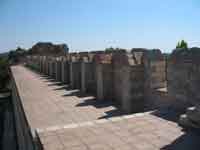 |
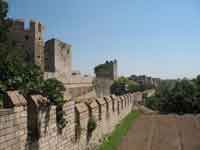 |
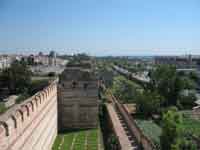 |
Theodosian Walls, Klicks to enlarge
The rebuilt walls consisted of three interconnected sets of walls, separated by ditches and moats. The walls were about five metres thick and up to twenty metres high. These walls were almost inpenetrable, saving the city during sieges from the Bulgars, Arabs, and Rus', among others. In the northwestern corner of the city the Theodosian Walls were relatively weaker, but were expanded by Leo I. The northern coast of the city, along the Golden Horn, also had a separate set of walls.
The inner walls had massive square or hexagonal towers. The southern end of the walls, at the Sea of Marmara, was the location of the Marble Tower. There were ten gates, the four major ones being the Golden Gate at the southern end, the Selymbria Gate leading to the Forum of Constantine and Hagia Sophia, the Adrianople Gate connecting Constantinople's Mese (the main street) with the city of Adrianople and the Via Egnatia, and the Blachernae Gate in the north.
The first attackers to break through the walls were the knights of the Fourth Crusade, who managed to scale the sea walls and also break the Wall of Leo in the northwestern Blachernae section of the city.
The second and final time the walls were breached was during the Siege of Constantinople in 1453, by the Ottomans; however, they did not break through by force, but entered through the Adrianople Gate, which happened to be open, apparently accidentally but possibly through treachery. A large plaque today marks the spot where the Ottomans entered.
Under the Ottomans, the Golden Gate, known to them as Yedikule ("the Seven Towers"), was used as a prison. Many parts of the walls are still standing today and are a testament to the extraordinary longevity of the empire. They have been damaged by recent earthquakes, but many sections have also been restored. The wall runs through the suburbs of modern Istanbul, with a belt of parkland flanking their course. The walls are pierced at intervals by modern roads leading westwards out of the city.
Stephen Turnbull, Peter Dennis (Illustrator), The Walls Of Constantinople 324-1453 AD (Fortress) (Paperback) Osprey Publishing (UK) (November 15, 2004) ISBN: 184176759X
| Ancient Greece
Science, Technology , Medicine , Warfare, , Biographies , Life , Cities/Places/Maps , Arts , Literature , Philosophy ,Olympics, Mythology , History , Images Medieval Greece / Byzantine Empire Science, Technology, Arts, , Warfare , Literature, Biographies, Icons, History Modern Greece Cities, Islands, Regions, Fauna/Flora ,Biographies , History , Warfare, Science/Technology, Literature, Music , Arts , Film/Actors , Sport , Fashion --- |
Retrieved from "http://en.wikipedia.org"
All text is available under the terms of the GNU Free Documentation License

